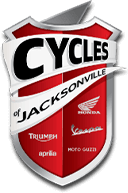ATV Helmets
Choosing an ATV Helmet
 There are more uses for an ATV than you might ever imagine, and for many owners these vehicles are incredibly important. But as all-terrain vehicles, ATVs often work in some uneven or sometimes hazardous terrain and a crash can threaten the rider's safety. A helmet is the most important piece of safety equipment in this situation, and if you're new to riding you'll want to put some major thought into what ATV helmet you buy. This short guide offers an overview on some of the ins and outs of buying an ATV helmet. Read on to learn about things like fit and safety rating in helmets. When you're looking for a new ATV, stop by Cycles Of Jacksonville. We're located in Jacksonville, Florida and we're near St. Augustine and Orlando.
There are more uses for an ATV than you might ever imagine, and for many owners these vehicles are incredibly important. But as all-terrain vehicles, ATVs often work in some uneven or sometimes hazardous terrain and a crash can threaten the rider's safety. A helmet is the most important piece of safety equipment in this situation, and if you're new to riding you'll want to put some major thought into what ATV helmet you buy. This short guide offers an overview on some of the ins and outs of buying an ATV helmet. Read on to learn about things like fit and safety rating in helmets. When you're looking for a new ATV, stop by Cycles Of Jacksonville. We're located in Jacksonville, Florida and we're near St. Augustine and Orlando.
ATV Helmet Design
ATV riding can often be an almost athletic activity. When looking for an ATV helmet, you'll want one that's lightweight, well-ventilated, and provides protection to every angle of your head. ATV and motocross helmets fit this bill. Some even feature visors for keeping out the sun. Most ATV helmets feature full-face protection, which helps to protect your chin and mouth.
Fit
One of the most important considerations when buying an ATV helmet is fit. Human heads aren't all shaped the same, so you can't always count on one manufacturer or model of helmet to fit your specific head shape. When fit correctly, a helmet shouldn't move just because you tilt your head. It also shouldn't pinch or pressure your head. Your helmet also shouldn't cut off any of your field of vision and it should be properly ventilated, especially if you live and ride in a warmer climate.
Safety Ratings
With flashy graphics explaining features and trademarked technology, it's easy to get confused about what helmets protect your head the best. The best way to tell a helmet's quality though, is to check its safety ratings. The main crash testing authority is the Department of Transportation, or DOT. These tests are generally considered the baseline of safety and it's probably not worth it to invest in a helmet that doesn't have this basic level of quality.
Another crash test rating organization is Snell, an independent group that provides its own level of rigorous testing. Many riders believe Snell is more or less the gold standard for safety ratings. If your helmet doesn't have some level of crash test rating, it could be that it hasn't been subjected to rigorous testing and no one knows what level of protection it will actually offer.
Eye Protection
Depending on what style of helmet you buy, you'll probably get the choice of a few different styles of eye protection. Traditional ATV and motocross helmets generally feature an open eye area that allows for the use of goggles. With this, riders can choose their own eye protection that's built to their personal needs. For example, one rider might buy goggles with anti-reflective coating, while another might choose a pair with anti-fogging properties. Some types of motorcycle helmet use a face shield instead of a goggle set up. This can be a good solution because it offers more complete protection. Unfortunately, face shields can sometimes shatter so they should be avoided for more sport-type riding.
Replacing a Helmet
Eventually you'll need to replace your helmet, and the rule of thumb is that it should be replaced after any crash or fall. Even being dropped on the ground can compromise a helmet's integrity. If you see any obvious cracking or damage (even if you weren't in a wreck or didn't drop your helmet) it's time to replace your helmet. This isn't one of those situations where you should cut corners or ignore warning signs. You might be putting your own life in your hands if you do.
Helmets are incredibly important for ATV riding. If you're still looking for the right ATV, stop by Cycles Of Jacksonville. We're located in Jacksonville, Florida, and we proudly serve St. Augustine and Orlando.
